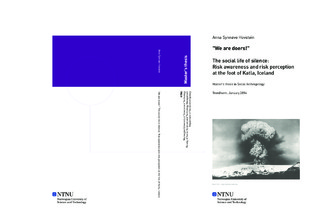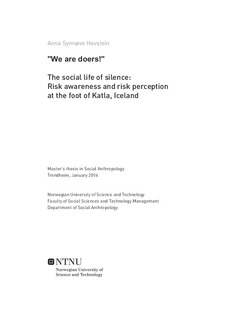| dc.description.abstract | Being an active volcano, Katla has followed a fairly distinct cyclical pattern of eruptions. According to historical records and expert knowledge, the volcano is now long overdue. The aim of this thesis is to investigate how locals in the area closest to Katla, Mýrdalur, relate to risk in a way that makes it possible to continue living there?
The local population of Mýrdalur demonstrates a keen awareness of the predicament outlined by the scientists. Still, they rarely ever think or talk about Katla; “Katla will come when she comes” they say. Risk perception – the sense of risk - is exceptionally low, even though risk awareness is high. The potential hazards due to Katla are simply out of mind, and certainly not a topic of conversation between locals. Rather, in their way of life it is a conscious Non-Topic except when going through the evacuation drill initiated by the Icelandic state and carried out by the local rescue team.
People in Mýrdalur live in a natural environment that often demands their attention and in everyday life nature overall outplays even the unintended attempts from “outsiders” to remind locals of Katla. Daily tasks and daily worries drown out even precautions one might take. Locals are used to living in this natural environment and know how to (or should know how to) behave in these surroundings.
Natural sciences talk about risk as something that can be calculated, but these calculations say little about the human beings dealing with risk. Cultural theoretician, Robert Paine, has been occupied with the paradox that risk perception seems to be non-existing in situations connected with extreme danger. Social and cultural processing is important for how people adjust to risk. In Mýrdalur, a life where risk perception is low or non-existent is sustained through shared beliefs of Katla being a non-topic. “Outsiders’ ” attempts to remind locals about the “situation” bring risk awareness. Still, silence about Katla and risk due to Katla is conspicuous. It appears that this silence helps to down play the risk and fuels the non-construction of risk. Following; down playing and non-construction of risk becomes a key element for maintaining a stable life and all in all simply makes it possible to live there.
Locals rather focus on what to do when it happens; “We are doers,” they claim, and “we deal with the situation when it arises.” | nb_NO |

